Advanced Filter and Search Concepts
- 19 minutes to read
- Filter Expressions
- Filter Expression Syntax
- Filtering Data in Code
- Override Current Grid Filters
- Filter Modes: Display Text vs Value
- Customize Filtering Dropdown Menus
- Automatic Filtering Row API
- Filtering Attributes Support
- Searching for Records and Rows
- Group Filters
- Filter Glyphs
Filter Expressions
A filter expression is a formula (or a set of formulas) that specifies how data should be filtered. Each expression contains three parts:
- a data field whose values should be filtered;
- a filtering value that should be compared to records stored in the data field;
- an operator that compares data field values with a filtering value.
For example, the following expression selects all the “Count” data field values that are greater than 5 but less than 20:
[Count] Between ('5', '20')
Filter Expression Syntax
The table below enumerates most frequently used operators. To learn more, see the Criteria Language Syntax article.
Operator | Description | Example |
|---|---|---|
= | Equals. Selects data field values that equal the entered filtering value. | [OrderDate] = #2016-01-01# |
<> | Does not equal. Selects data field values that are not equal to the entered filtering value. | [OrderDate] <> #2016-01-01# |
> | Is greater than. Selects data field values that are greater than the entered filtering value. | [OrderDate] > #2016-01-01# |
>= | Is greater than or equal to. Selects data field values that are greater than the entered filtering value or equal to it. | [OrderDate] >= #2016-01-01# |
<= | Is less than or equal to. Selects data field values that are less than the entered filtering value or equal to it. | [OrderDate] >= #2016-01-01# |
< | Is less than. Selects data field values that are less than the entered filtering value. | [OrderDate] >= #2016-01-01# |
Between | Is between. Selects data field values that belong to the specific value interval. | [CustomerID] Between (‘1’, ‘100’) |
Not Between | Is not between. Selects data field values that lie outside the specific value interval. | Not [CustomerID] Between (‘1’, ‘100’) |
Contains | Contains. Selects data field values that contain the filtering value. | Contains([ShipCountry], ‘land’) |
Not Contains | Does not contain. Selects data field values that do not contain the filtering value. | Not Contains([ShipCountry], ‘land’) |
Starts with | Begins with. Selects data field values that start with the filtering value. | StartsWith([ShipCountry], ‘G’) |
Ends with | Ends with. Selects data field values that ends with the filtering value. | Ends with([ShipCountry], ‘ia’) |
In | Is any of. Selects data field values that equal any of the entered filtering values. | [ShipCountry] In (‘Germany’, ‘Italy’, ‘USA’) |
Not In | Is none of. Selects data field values that do not equal any of the entered filtering values. | Not [ShipCountry] In (‘Germany’, ‘Italy’, ‘USA’) |
Like | Is like. Selects data field values that contain the filtering value. Accepts wildcards: ‘_’ to replace a single character, ‘%’ to replace any number of characters. | [OrderDate] Like ‘%2011’ same as Contains ([OrderDate], ‘2011’) |
Not Like | Is not like. Selects data field values that do not contain the filtering value. Accepts wildcards: ‘_’ to replace a single character, ‘%’ to replace any number of characters. | Not [OrderID] Like ‘103__’ same as Not [OrderID] Between (‘10300’, ‘10399’) |
Is Null | Is null. Selects null values. | [ShipRegion] Is Null |
Is Not Null | Is not null. Excludes null values. | [ShipRegion] Is Not Null |
- String values must be enclosed within single quote characters. If a single quote character needs to be included as a literal to a filter, it must be doubled (e.g., [ProductID] LIKE ‘Uncle Bob’’s%’);
Date-time values must be wrapped with the ‘#’ characters and represented using a culture-independent (invariant) format. The invariant culture is based on the English culture, but some of the idiosyncratic English formats have been replaced by more globally-accepted formats. Below are some of the culture-independent formats for representing date-time values.
MM/dd/yyyy — 07/30/2008
dd MMM yyyy — 30 JUL 2008
yyyy-MM-dd — 2008-07-30
yyyy-MM-ddTHH:mm:ss — 2008-07-30T22:59:59
yyyy-MM-dd HH:mm:ssZ — 2008-07-30 15:59:59Z
Filtering Data in Code
ColumnView.ActiveFilterString and ColumnView.ActiveFilter
Allow you to pass a filtering expression as a string in order to apply data filtering to the entire View. The following sample applies filtering by the “Order Date” and “Ship Region” fields.
gridView1.ActiveFilterString = "[OrderDate] Between (#01 JAN 2010#, #01 DEC 2010#) And [ShipRegion] Is not null";
//or
gridView1.ActiveFilter.Clear();
gridView1.ActiveFilter.NonColumnFilter = "[OrderDate] Between (#01 JAN 2010#, #01 DEC 2010#) And [ShipRegion] Is not null";
Allows you to filter data by specific columns. The FilterInfo property accepts objects of the ColumnFilterInfo type.
string filterString = "[UnitPrice] > 20 AND [UnitPrice] < 30 AND [InStock] = true";
gridView.Columns["UnitPrice"].FilterInfo = new ColumnFilterInfo(filterString);
A ColumnFilterInfo object can hold any valid filter expression, including an expression that filters another column’s data.
string filterString = "[ShipCountry] = 'Canada'";
gridView1.Columns["ShipCity"].FilterInfo = new ColumnFilterInfo(filterString);
ViewFilter.NonColumnFilter (accessed through the ColumnView.ActiveFilter property)
Utilize this property to apply a filter expression that is not associated with any specific grid column. As a result, end users cannot use the column’s drop-down filter to clear or modify this filter.
Allows you to hide particular rows that exist in the data source or make them visible (regardless of the grid’s filter).
Override Current Grid Filters
Handle the ColumnView.CustomRowFilter event to manually show or hide Data Grid rows, even if they do not match active Grid filters. The following sample makes rows with the “USA” value in the “Country” column always visible:
using DevExpress.XtraGrid.Views.Base;
private void gridView1_CustomRowFilter(object sender, RowFilterEventArgs e) {
ColumnView view = sender as ColumnView;
string country = view.GetListSourceRowCellValue(e.ListSourceRow, "Country").ToString();
// Check whether the current row contains "USA" in the "Country" field.
if (country == "USA") {
// Make the current row visible.
e.Visible = true;
// Prevent default processing, so the row will be visible
// regardless of the view's filter.
e.Handled = true;
}
}
Handle the ColumnView.SubstituteFilter event to update or replace the filter that is about to be applied with a custom filter.
The code below shows how to handle the SubstituteFilter event to update the filter applied in the grid with a filter selected in a combo box.

using DevExpress.Data.Filtering;
using DevExpress.Data;
private void Form1_Load(object sender, EventArgs e) {
DataSet ds = new DataSet();
ds.ReadXml("nwind.xml");
this.GridControl.DataSource = ds;
this.GridControl.DataMember = "Orders";
this.GridView.ActiveFilterCriteria = CriteriaOperator.Parse("Freight > 0");
}
private void GridView_SubstituteFilter(object sender, SubstituteFilterEventArgs e) {
e.Filter &= CriteriaOperator.Parse("getyear(OrderDate) = ?", Convert.ToInt32(this.beiShowByYear.EditValue));
}
private void beiShowByYear_EditValueChanged(object sender, EventArgs e) {
CriteriaOperator filter = this.GridView.ActiveFilterCriteria;
this.GridView.BeginDataUpdate();
try {
this.GridView.ActiveFilterCriteria = null;
this.GridView.ActiveFilterCriteria = filter;
} finally {
this.GridView.EndDataUpdate();
}
}
Note
A complete sample project is available at https://github.com/DevExpress-Examples/how-to-customize-the-filter-criteria-before-it-is-applied-to-gridview-e4119.
Filter Modes: Display Text vs Value
The figure below illustrates a classic drop-down menu invoked for a DateTime “Order Date” column. This column has a custom ‘yyyy’ display format, which leaves only years visible. However, these dates are still unique and since the Data Grid filters data by values by default, the pop-up filter menu displays an item for each date. From end-users’ perspective, items are duplicated multiple time (left figure). Utilize the GridColumn.FilterMode property to switch this filter mode to DisplayText. In this mode, the Data Grid filter menus are populated with records’ display text strings (right figure).
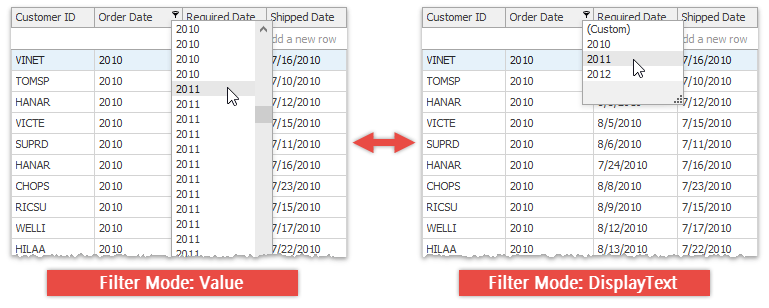
An automatic filtering row has its own dedicated property for changing the filtering mode: WindowsFormsSettings.ColumnAutoFilterMode.
Customize Filtering Dropdown Menus
ColumnView.ShowFilterPopupExcel, ExcelFilterOptions
Allow you to customize Excel-style menus. The sample below demonstrates how to remove the “Is Null” and “Is Not Null” items.
//affects one specific Data Grid
void gridView1_ShowFilterPopupExcel(object sender, FilterPopupExcelEventArgs e) {
e.ShowNulls = false;
}
//affects all Data Grid controls within an application
DevExpress.Utils.Filtering.ExcelFilterOptions.Default.ShowNulls = false;
ColumnView.FilterPopupExcelData
Allows you to modify and remove items within Excel-styled filter dropdowns, as well as add custom items that apply specific filtering conditions. The code snippet below adds custom filtering options to the “Modification” and “MPG City” columns.
void gridView_FilterPopupExcelData(object sender, Views.Grid.FilterPopupExcelDataEventArgs e) {
if(e.Column == bcModification) {
e.AddFilter("Automatic Transmission (6-speed)", "Contains([" + e.Column.FieldName + "], '6A')");
e.AddFilter("Automatic Transmission (8-speed)", "Contains([" + e.Column.FieldName + "], '8A')");
e.AddFilter("Manual Transmission (6-speed)", "Contains([" + e.Column.FieldName + "], '6M')");
e.AddFilter("Manual Transmission (7-speed)", "Contains([" + e.Column.FieldName + "], '7M')");
e.AddFilter("Variomatic Transmission", "Contains([" + e.Column.FieldName + "], 'VA')");
e.AddFilter("Limited Edition", "Contains([" + e.Column.FieldName + "], 'Limited')");
}
if(e.Column == bcMPGCity) {
e.AddFilter("Fuel Economy (High)", "[" + e.Column.FieldName + "]<=15");
e.AddFilter("Fuel Economy (Medium)", "[" + e.Column.FieldName + "]>15 AND [" + e.Column.FieldName + "]<25");
e.AddFilter("Fuel Economy (Low)", "[" + e.Column.FieldName + "]>=25");
}
}
ColumnView.QueryCustomFunctions
To create a custom filter function (e.g., ‘discount is more than 15%’), and add this function to Excel-style pop-up filter menus and the filter editor, do the following:
- Implement a custom function;
- Register the function;
- Add the function to pop-up filter menus and the filter editor in a QueryCustomFunctions event handler.
using DevExpress.Data.Filtering;
IsBlackFridayDiscountFunction.Register();
gridView1.QueryCustomFunctions += OnQueryCustomFunctions;
void OnQueryCustomFunctions(object sender, CustomFunctionEventArgs e) {
if(e.PropertyName == "Discount")
e.Add(IsBlackFridayDiscountFunction.FunctionName);
}
public class IsBlackFridayDiscountFunction : ICustomFunctionDisplayAttributes {
// See the QueryCustomFunctions event for the complete implementaiton.
}
Tip
To add custom functions to filter menus and filter editors of all DevExpress controls in the application, use the static (Shared in VB) QueryCustomFunctions event.
Regular filter menus display the “(Custom)” item. Clicking this item invokes a Filter Dialog that allows end-users to build filtering criteria from multiple simple expressions. The CustomFilterDialog event allows you to customize this dialog or change the “(Custom)” item’s action. The code sample below suppresses the Filter Dialog when end users click “(Custom)” for the “Unit Price” column. Instead, clicking this item applies a $10 ~ $30 price filter.
private void gridView_CustomFilterDialog(object sender, DevExpress.XtraGrid.Views.Grid.CustomFilterDialogEventArgs e) {
if (e.Column.FieldName != "UnitPrice") return;
string filterSting = "[UnitPrice] > 10 AND [UnitPrice] < 30";
string displayText = "[UnitPrice] > $10.00 AND [UnitPrice] < $30.00";
ColumnFilterInfo columnFilter = new ColumnFilterInfo(filterSting, displayText);
e.FilterInfo = columnFilter;
e.Handled = true;
}
ColumnView.ShowFilterPopupListBox
Handle this event to modify regular drop-down list menus. The sample below demonstrates how to add the “Important” item to a filtering menu invoked for the “Priority” column. Applying this custom filter selects records with Medium and High priorities.
private void gridView_ShowFilterPopupListBox(object sender, FilterPopupListBoxEventArgs e) {
if (e.Column.FieldName != "Priority") return;
// Get the first value item's index.
int index;
for (index = 0; index < e.ComboBox.Items.Count; index++) {
object item = e.ComboBox.Items[index];
if (item is FilterItem) {
object itemValue = ((FilterItem)item).Value;
if (itemValue is FilterItem || itemValue is ColumnFilterInfo) continue;
break;
}
}
// Create a filter criterion to select records with the "High" and "Medium" priorities.
string filterString = "([Priority] == 3 OR [Priority] == 2)";
string filterDisplayText = "[Priority] == High OR [Priority] == Medium";
ColumnFilterInfo filterInfo = new ColumnFilterInfo(filterString, filterDisplayText);
e.ComboBox.Items.Insert(index, new FilterItem("Important", filterInfo));
}
ColumnView.ShowFilterPopupCheckedListBox
Allows you to customize checked list box menus. The code below removes items that start with “Help” and disables items that start with “Data”.
private void gridView_ShowFilterPopupCheckedListBox(object sender, FilterPopupCheckedListBoxEventArgs e) {
if (e.Column.FieldName != "Name") return;
for (int i = 0; i < e.CheckedComboBox.Items.Count; i++) {
CheckedListBoxItem item = e.CheckedComboBox.Items[i];
string itemValue = (string)(item.Value as FilterItem).Value;
// Disable checked items that start with "Data".
if (itemValue.StartsWith("Data"))
e.CheckedComboBox.Items[i].Enabled = false;
// Remove checked items that start with "Help".
if (itemValue.StartsWith("Help")) {
e.CheckedComboBox.Items.Remove(item);
i--;
}
}
}
ColumnView.ShowFilterPopupDate
Allows you to customize calendar filters. The code sample below adds a custom “Last Year” filtering item to calendar menus.
private void gridView1_ShowFilterPopupDate(object sender, FilterPopupDateEventArgs e) {
if(e.Column.FieldName != "Date") return;
e.List.Clear();
DateTime firstDayOfThisYear = new DateTime(DateTime.Today.Year, 1, 1);
DateTime firstDayOfLastYear = firstDayOfThisYear.AddYears(-1);
CriteriaOperator lastYear = new BinaryOperator(
e.Column.FieldName, firstDayOfLastYear, BinaryOperatorType.GreaterOrEqual);
CriteriaOperator thisYear = new BinaryOperator(
e.Column.FieldName, firstDayOfThisYear, BinaryOperatorType.Less);
CriteriaOperator crit = new GroupOperator(GroupOperatorType.And, lastYear, thisYear);
e.List.Add(new DevExpress.XtraEditors.FilterDateElement("Last Year", "", crit));
}
Automatic Filtering Row API
GridOptionsFilter.AllowAutoFilterConditionChange
Specifies whether or not the auto-filtering row’s condition selector is visible.
OptionsColumnFilter.AutoFilterCondition
Specifies the filter criteria operator for this column (“Equals”, “Like”, “Greater”, etc.).
OptionsColumnFilter.ImmediateUpdateAutoFilter
If this setting is enabled, the Data Grid filters its records immediately after end-users modify the filter condition. Otherwise, filtering will not be applied until a user presses the Enter key or moves focus to another cell.
GridView.ShowAutoFilterConditionsMenu
Call this method from code to invoke the automatic filtering row popup menu for the specific column.
GridView.SetAutoFilterValue, GridView.GetAutoFilterValue
Methods that allow you to retrieve the currently applied auto-filtering row condition and apply a new one from code.
GridView.ResetAutoFilterConditions
Clears all data filtering applied through the automatic filtering row.
Filtering Attributes Support
In code-first data sources, you can mark specific properties with DevExpress filtering attributes to change editors that appear inside Excel-style filtering menus. For example, in the code sample below the integer “ID” property is recognized as a numeric property, and a corresponding Excel-style filter shows two text boxes and a range trackbar for this property. Declaring the FilterLookup attribute before this property allows you to change these default editors with a check-list box control.
using DevExpress.Utils.Filtering;
public class Customer {
[FilterLookup]
public Int32 ID { get; set; }
//. . .
}
Searching for Records
Allows you to manually start a search.
ColumnViewOptionsFind.FindFilterColumns
Initially, this property is set to “*”. In this instance, all visible columns/card fields are searched. To search specific columns/fields, assign the corresponding field names to the FindFilterColumns property, delimiting them with the “;” character. This property also allows you to limit the search columns o prevent highlighting text in non-searchable columns.
ColumnView.LocateByValue, ColumnView.LocateByDisplayText
Utilize these methods to find rows with the values and\or display text.
//find rows by cell values
private void btn_LocateRow_ItemClick(object sender, ItemClickEventArgs e) {
int rowHandle = gridView.LocateByValue(gridView.FocusedRowHandle + 1, gridView.Columns["Category"], 1);
gridView.FocusedRowHandle = rowHandle;
}
//find rows by cell display text
private void btn_LocateRow_ItemClick(object sender, ItemClickEventArgs e) {
int rowHandle = gridView.LocateByDisplayText(gridView.FocusedRowHandle + 1, gridView.Columns["Category"], "Beverages");
gridView.FocusedRowHandle = rowHandle;
}
Group Filters
OptionsColumnFilter.PopupExcelFilterGrouping
Allows you to group values in a column’s filter menu by values in another column. When this feature is enabled, users can use a filter menu to filter data by multiple columns.
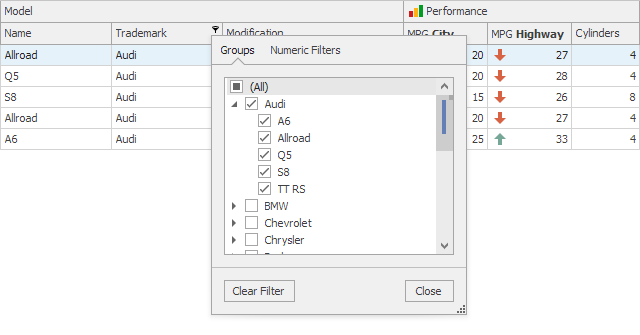
The OptionsColumnFilter.PopupExcelFilterGrouping property specifies data fields (columns) by which to group values in a specific column’s filter menu. Data fields (columns) should be specified by their names as strings separated by a comma, semicolon, space or tab character. The code below shows how to display available models below each trademark as illustrated in the figure above.
//Customize the Trademark column's filter menu.
bcTrademark.OptionsFilter.PopupExcelFilterGrouping = "Trademark;Name";
//The customized column's values are displayed at the root level by default; you can omit its name ("Trademark").
//The code below has the same effect.
bcTrademark.OptionsFilter.PopupExcelFilterGrouping = "Name";
You can specify two or more data fields to group filter values by multiple columns. The field names’ order determines the group hierarchy. To show available models below each trademark in the Name column’s filter menu, change the group hierarchy using the following code:
//Customize the Name column's filter menu.
//The customized column's values are not displayed at the root level in this case, its name ("Name") cannot be omitted.
bcName.OptionsFilter.PopupExcelFilterGrouping = "Trademark;Name";
As a result, values from the Trademark column are shown at the root level.
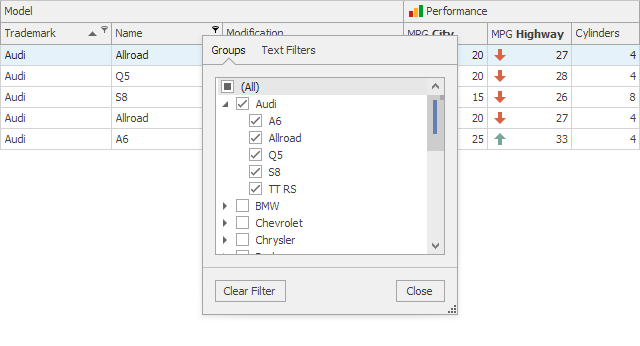
In the case of a Code First data source, you can annotate data fields with the FilterGroup attribute using the same syntax in the attribute parameter.
[Utils.Filtering.FilterGroup("Trademark;Name")]
public string Name { get; set; }
public string Trademark { get; set; }
Filter Glyphs
Filter menus can display glyphs against filter values.
Combo box editor images: if column values are edited using the combo box displaying images against items (see ImageComboBoxEdit), the images are also displayed in the filter menu.
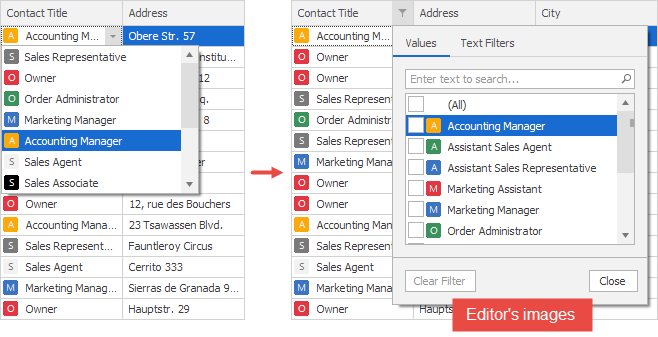
To edit column values using the image combo box:
- create an editor (see RepositoryItemImageComboBox);
- assign an image list to the editor (see RepositoryItemImageComboBox.SmallImages, RepositoryItemImageComboBox.LargeImages)
- associate menu items with images in the image collection (see ImageComboBoxItem.ImageIndex);
- specify the image alignment if required (see RepositoryItemImageComboBox.GlyphAlignment);
- assign the editor to the column (see GridColumn.ColumnEdit).
private void gridControl1_Load(object sender, EventArgs e) { RepositoryItemImageComboBox combo = new RepositoryItemImageComboBox(); combo.Items.Add(new ImageComboBoxItem("Sales Agent", 0, 0)); combo.Items.Add(new ImageComboBoxItem("Owner", 1, 1)); // ... add your items here. combo.SmallImages = imageCollection1; combo.GlyphAlignment = HorzAlignment.Near; colContactTitle.ColumnEdit = combo; }Custom images: you can substitute editor images, and/or change the image alignment. It is also possible to display custom images even if a column does not use the image combo box as an editor.
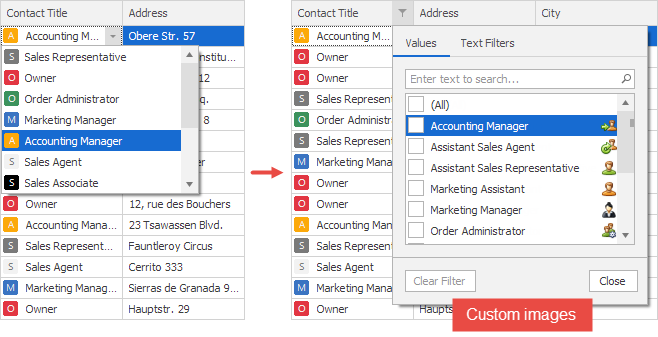
To do this:
- handle the ColumnView.FilterPopupExcelData event;
- use the Images event argument to provide an image list (this collection contains images fetched from the editor by default);
- read the DataItems event argument to get access to filter items;
- use an item’s ImageIndex property to associate the item with an image in the list;
- use the ImageAlignment event argument to specify whether the images are aligned to the near or far edge or the menu (the images are aligned as in the editor by default);